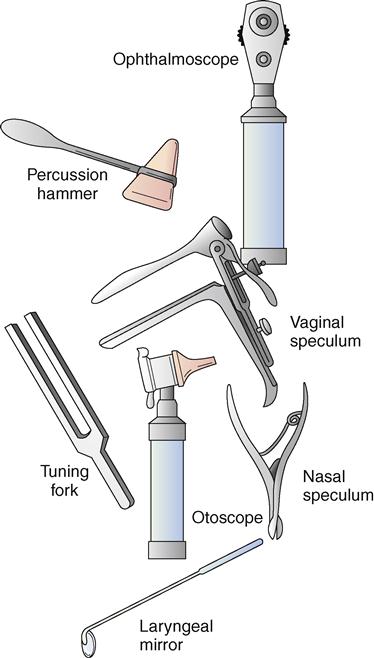Assisting with the physical examination
Objectives
• Define the key terms listed in this chapter.
• Explain what to do before, during, and after an examination (exam).
• Identify the equipment used for an exam.
• Describe how to prepare and drape a person for an exam.
• Explain the rules for assisting with an exam.
• Perform the procedure described in this chapter.
Key terms
dorsal recumbent position The supine position with the legs together; horizontal recumbent position
genupectoral position See “knee-chest” position
horizontal recumbent position See “dorsal recumbent position”
laryngeal mirror An instrument used to examine the mouth, teeth, and throat
lithotomy position The woman lies on her back with her hips at the edge of the exam table, her knees are flexed, her hips are externally rotated, and her feet are in stirrups
nasal speculum An instrument used to examine the inside of the nose
ophthalmoscope A lighted instrument used to examine the internal eye structures
otoscope A lighted instrument used to examine the external ear and the eardrum (tympanic membrane)
percussion hammer An instrument used to tap body parts to test reflexes; reflex hammer
tuning fork An instrument vibrated to test hearing
vaginal speculum An instrument used to open the vagina for examining it and the cervix
Doctors and many RNs perform physical exams. Exams are done to:
Your role
Your role depends on center policies and procedures. It also depends on what the examiner prefers. You may do some or all of the following:
• Collect equipment and supplies.
• Prepare the room for the exam.
• Transport the person to and from the exam room.
• Measure vital signs, weight, and height.
• Position and drape the person.
• Hand equipment and supplies to the examiner.
• Help the person dress or to a comfortable position after the exam.
Equipment
The instruments in Figure 32-1 are used in the exam:
• Laryngeal mirror—used to examine the mouth, teeth, and throat.
• Nasal speculum—used to examine the inside of the nose.
• Ophthalmoscope—a lighted instrument used to examine the internal eye structures.
• Percussion hammer (reflex hammer)—used to tap body parts to test reflexes.
• Tuning fork—vibrated to test hearing.
• Vaginal speculum—used to open the vagina to examine it and the cervix.

Some centers have exam trays in the supply department. If not, collect the items listed in the procedure: Preparing the Person for an Examination, p. 498. Arrange them on a tray or table.



